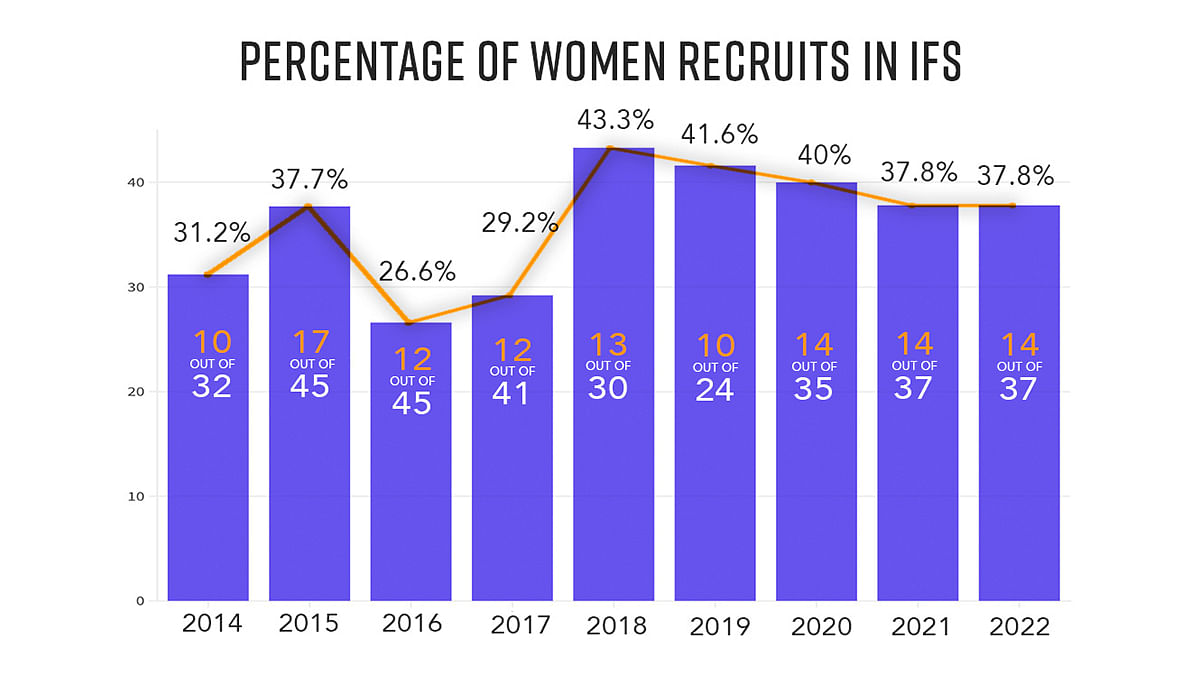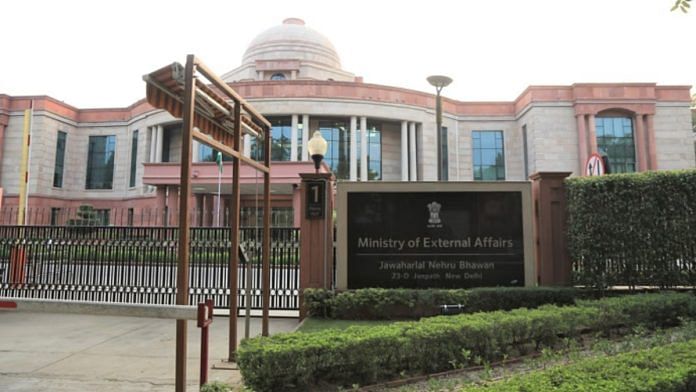New Delhi: The number of women recruited into the Indian Foreign Service (IFS) is steadily growing, with a 6.6 percent rise in the nine-year period from 2014-2022, shows data from the Department of Personnel & Training (DoPT).
Former women ambassadors as well as young recruits currently serving in missions across the world, hail this as a “positive sign”, though adding that more can be done by appointing women in top positions.
According to ThePrint’s analysis of data from the DoPT, 31.2 percent of the 2014 IFS cadre (10 out of 32) were women. In 2022, this number rose to 37.8 percent (14 out of 37).
Notably, in 2018, 2019 and 2020, the number of women recruits in the foreign service had exceeded the 40-percent mark.

“I see this as a positive sign, especially because the percentage of women recruits in the IFS is usually higher than in services like IPS,” a young woman IFS officer from the 2022 batch told ThePrint.
That year, 37.8 percent of new recruits were women. Comparatively, the share of women recruits was 30 percent (62 out of 206) in the IPS and 43.3 percent (78 out of 180) in the IAS, in 2022.
In early independent India, women officers in the foreign service faced a myriad of challenges. They were often not picked for “hardship” postings or in conflict zones and had to seek permission from the Indian government before getting married, unlike their male colleagues.
C.B. Muthamma was among the trailblazing women diplomats who successfully challenged these rules in the Supreme Court in 1979.
When former ambassador Ruchi Ghanashyam joined the IFS in 1982, she was one of four women in a batch of 15. She argues, however, that the restrictions on women had lessened by the time she was recruited.
“Four girls out of a batch of 15 isn’t a great percentage but the IFS has come a long way since the ‘80s. Even back then, restrictions on women in hardship postings had significantly reduced. I myself served in Islamabad during the 1999 Kargil war,” she argues.
Ghanashyam had served as a Counsellor (Political, Press & Information) at the Indian High Commission in Pakistan during the 1999 Kargil war.
In absolute numbers, only about four more women have been added to the IFS every year since 2014. Political scientist Kanti Bajpai, who has previously criticised the small size of the IFS and its “highly selective” recruitment policy, says tripling the number of recruits can help achieve better gender parity.
“The strength of India’s foreign service is only about 800 for a country of 1.4 billion, whereas China has over 5,000 officers. If at least 100 candidates are picked for the IFS instead of 30, this may encourage more women to apply for the civil services in general, and help the foreign service inch closer to 50/50 gender parity,” Bajpai told ThePrint.
Such reforms are necessary as India seeks to become a leader of the ‘Global South’ and the third largest economy in the world, he added.
A larger pool of recruits has previously resulted in a larger share of women in that pool, in absolute numbers. For example, 2015 saw the most number of women recruits (17) over the nine-year period, and the total number of recruits that year was 45 instead of the usual 30-35.
It may also be worth exploring how many women apply for the IFS and if low, how can their numbers be increased at the application stage, Bajpai added.
In a 2019 research paper titled ‘India’s Foreign Policy Capacity’, Bajpai and researcher Byron Chong argued that selectivity for the IFS is far too high. Nearly half a million men and women take the annual UPSC exam, of which a thousand are offered positions in the top services, and only 30 or so are offered the Foreign Service, they explained.
Also Read: Meet the women ambassadors posted in Delhi, a tight-knit and growing community
Women in top posts
A closer look at how many Indian women head diplomatic missions across the world reveals a not too rosy picture.
At present, women lead eight Indian diplomatic missions and not in high-profile capitals of the world. These include Armenia, Cambodia, Cyprus, Italy, Mauritius, Malta, New Zealand, Netherlands, Poland and Serbia. Ruchira Kamboj, India’s first woman ambassador to the United Nations (UN), vacated the post in New York when she retired on 1 June.
The situation is a far cry from 2008 when women were heading more than 25 Indian missions and consulates around the world, including in major capitals. At the time, Sujatha Singh was posted in Australia, Meera Shankar in Berlin and Nirupama Rao was serving in China. Both Singh and Rao would go on to become foreign secretaries.
“No territory seems forbidden or forbidding anymore,” senior journalist Seema Sirohi wrote in a report for Outlook at the time.
Today, only one of the seven secretary-level postings in the MEA is occupied by a woman — Neena Malhotra, who serves as Secretary (OSD & Political).
When it comes to the post of Foreign Secretary, three women in India’s history have occupied the position — Chokila Iyer (2001-02), Nirupama Rao (2009-11) and Sujatha Singh (2013-15).
The Foreign Secretary has traditionally been selected on the basis of seniority but in 2007, the then-Congress government’s pick for this post ruffled a few feathers.
In April 2007, Shiv Shankar Menon’s elevation to the foreign secretary was met with strong opposition by some of the officers in the foreign service. Veena Sikri, serving in Dhaka as the Indian High Commissioner to Bangladesh, returned to Delhi in protest.
Her husband, Rajiv Sikri, tendered his resignation and T.C.A. Rangachari, India’s then-ambassador to France too stepped down. Menon had superseded 16 of his seniors by being appointed to the post.
Veena Sikri later alleged gender bias, claiming that she was unfairly superseded for the post.
Sikri was a 1971-batch IFS officer and Menon was a year junior to her. She filed a right-to-information petition for details on the selection process, which was eventually denied by the government at the time.
The MEA went on to publicly deny the claims, and was quoted by Hindustan Times as saying: “As far as the Ministry of External Affairs is concerned, no women IFS officer has been denied her due in the last five years on the basis of gender.”
ThePrint reached Veena Sikri but she declined to comment.
(With inputs from Siya Gupta)
Also Read: Key ambassador appointments await Modi govt 3.0, foreign secretary & deputy NSA in race for US







Nice story !!